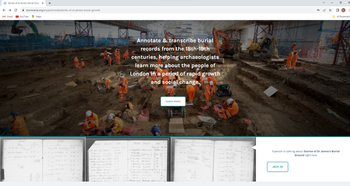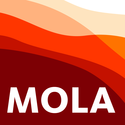Data from Stories of St James's Burial Ground, Euston, Camden, Greater London, 2021-2023 (HS2 Phase One)
High Speed Two Ltd., MOLA Northampton, 2023. https://doi.org/10.5284/1118189. How to cite using this DOI
Data copyright © High Speed Two Ltd. unless otherwise stated
This work is licensed under a The Open Government Licence (OGL).
Primary contact
High Speed Two Ltd.
2 Snowhill
Queensway
Birmingham
B4 6GA
United Kingdom
Tel: 08081 434 434
Resource identifiers
- ADS Collection: 5660
- DOI:https://doi.org/10.5284/1118189
- How to cite using this DOI
Introduction

The archive collection comprises two spreadsheets created from volunteers transcription of burial records St James's Burial Ground Euston, Camden, Greater London between 2021 and 2023.
Project Summary
High-Speed Rail 2 (HS2) is a major infrastructure project connecting cities across the UK with faster train lines and services. In London, contractors Mace Dragados Joint Venture (MDJV) are managing work near Euston Station where construction is taking place on the site of St James’s Burial Ground, a major 18th-19th century cemetery site. Ahead of this work, between 2018-2019, over 100 archaeologists and specialists from MOLA Headland Infrastructure excavated and record over 40,000 burials, the largest archaeological excavation of its kind ever undertaken in the UK. While this is giving us unique insight into the people who lived in London during a time of rapid growth and social change, further research was achieved through a citizen science project focused on the digital transcription of the relevant burial records associated with the site.
The Stories of St James's Burial Ground project sought volunteers using the Zooniverse platform to assist with the transcription of burial records in order to create a searchable digital archive. These records contain information about the thousands of ordinary Londoners buried at St James’s, including their names, addresses, cause of death and more.
The objective was to begin to understand the everyday details of who these people were and how they lived (and died), contributing to an unprecedented record of Georgian and Victorian urban life in London. All contributions were made online, no previous experience was needed and each volunteer could choose to do as much or as little as they could.
Re-Use Value Statement
The project has the potential to contribute to further research in several ways:
- Researchers can use the data search for individuals and interrogate it to provide evidence for specific hypotheses or trends – e.g. how many people died in different months of the year/how many women are recorded to die from childbirth and where they were buried etc etc.
- The Zooniverse data gathered could be correlated with the existing archaeological records generated during the excavation and post-excavation work, including osteology, small finds, and inscriptions of graves plates etc with the addresses, locations of burial, ages and cause of death available in the burial records. Such work would enable a richer understanding of the details of individuals but also open out research avenues (e.g. comparing deaths of those coming from certain parts of London and cross comparing it with diseases/conditions evident in the osteology).
- It could possibly also be used to compare to data from other burial grounds of a similar period (where similar information is taken).
- Whilst transcribing, Zooniverse volunteers made comments and also tagged certain pages with useful information identifying where certain information was missing or trends in specific data (e.g. changes in lot and plot management, numbers of twins or those buried together). It was not possible for MOLA to aggregate the data in an accessible manner for deposition but they have saved it and if resources were made available, such information could be aggregated to further enrich the dataset making it easier for researchers to account for data gaps or even inspire them towards different research avenues.






